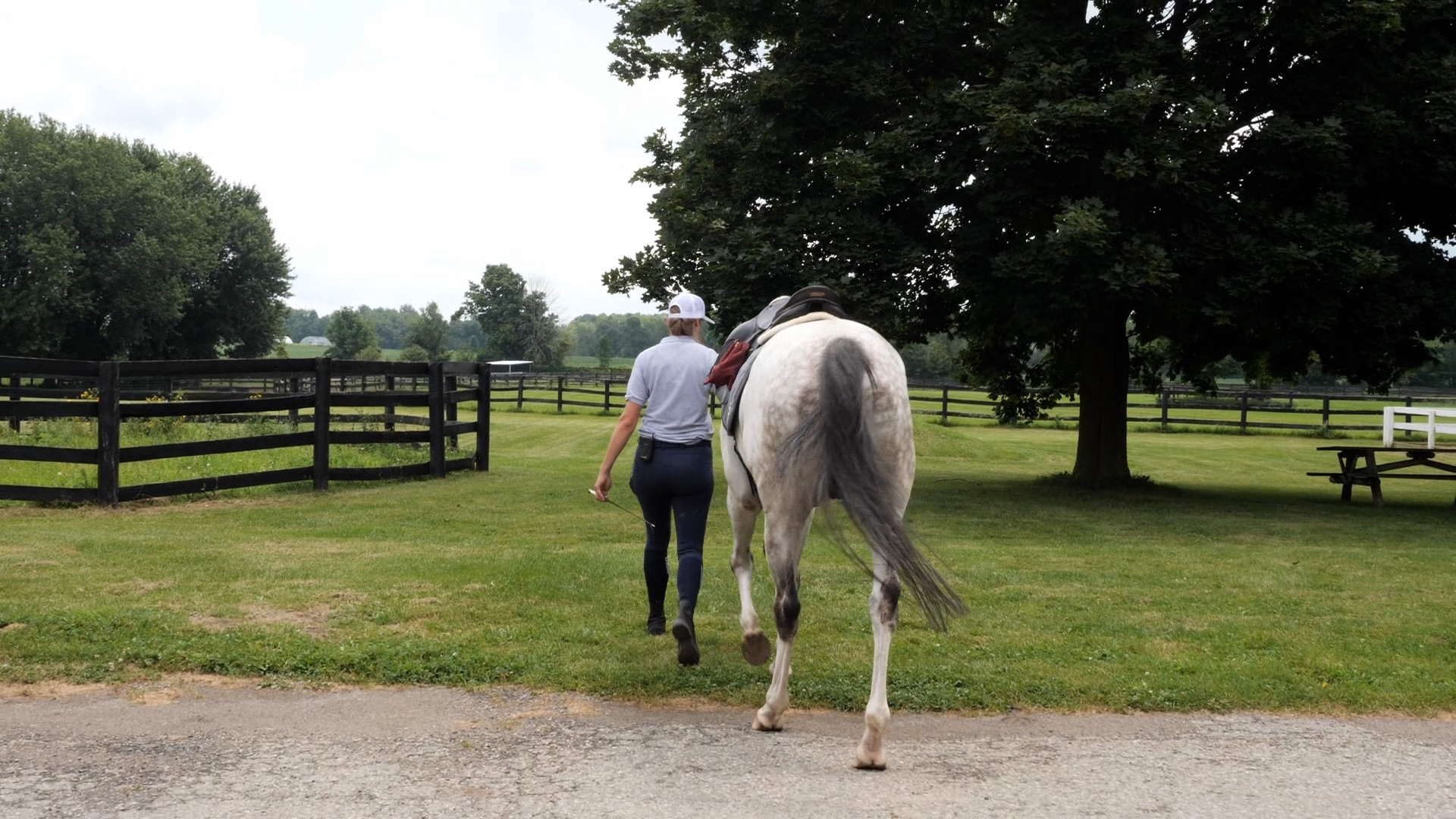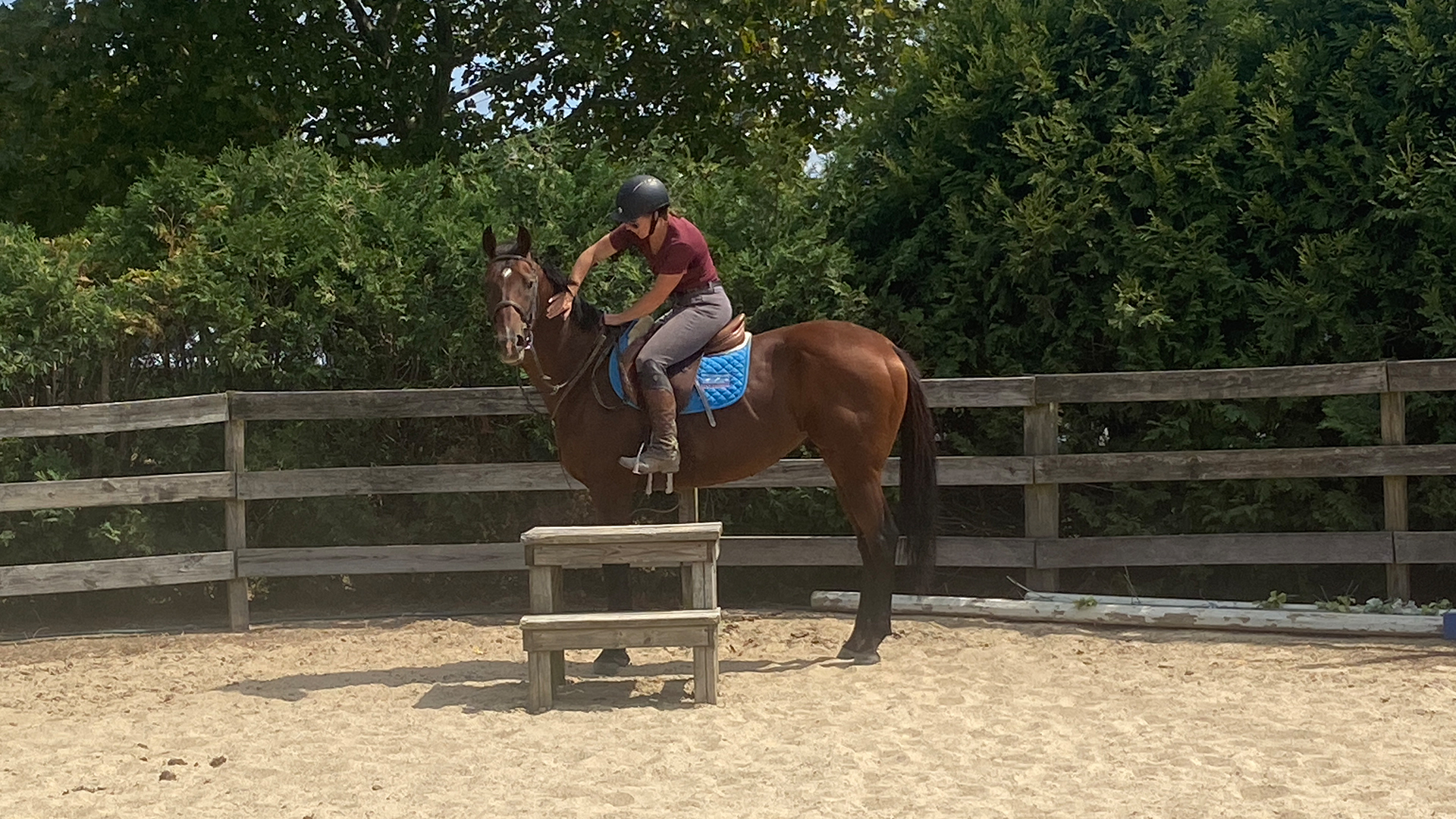Retraining
All Posts & News Press Releases Success Stories Aftercare Editorials Retraining Tips Supporter Features Equine-Assisted Learning Inspector Spotlights Hamburger Toggle Menu Previous Post Getting Started with Groundwork and Manners for Your Ex-Racehorse Getting Started with Groundwork and Manners for Your Ex-Racehorse By: Alexis Arbaugh April 11, 2025 Retraining Tags:Accredited Organization, Groundwork, LongRun Thoroughbre, Manners, Retraining, Thoroughbred Aftercare Alliacne Lauren Millet, LongRun Thoroughbred Retirement Society Thoroughbred Aftercare Alliance recently had the pleasure of speaking with Lauren Millet, the trainer at LongRun Thoroughbred Retirement Society, about her approach to retraining ex-racehorses. Based in Toronto, Canada, LongRun is a Thoroughbred Aftercare Alliance-accredited organization dedicated to the rehabilitation, retraining, and adoption of retired Thoroughbred racehorses. Growing up, Lauren frequented the racetracks in Canada and hoped that one day she would have a job working with racehorses. Years later, Lauren became the Farm Manager at LongRun, where she oversees the training and riding of all the horses that enter the facility. Her role involves assessing the training of each horse and building upon their foundation. Additionally, she evaluates each horse once the retraining process begins to determine the most suitable second career for them. “Groundwork in racehorses totally varies based on where they come from, who their groom was and what they were allowed to do at the racetrack,” writes Lauren. Nearly all racehorses are hand-walked almost daily from the time they are weaned, which instills good manners and ensures they walk confidently and respectfully beside their handlers. However, Lauren notes that most ex-racehorses are not taught the following: “how to move away from pressure, back up when asked, step over or around obstacles, stand in crossties or tied outside.” The life of a racehorse is quite different from that of a sport horse, so they’re taught different skills from an early age to help them succeed in their specific careers. “They [racehorses] are taught the things that they need to know at the track, such as: how to tie in a stall, lead to the left, pick all 4 feet from the left side etc.,” Lauren says. She encourages people to recognize the importance of understanding what that specific horse was taught on the track, as it directly influences how they should be trained off the track. At LongRun, horses arriving directly from the racetrack will either require rehabilitation with stall rest or benefit from a period of downtime before beginning their retraining program. “If a horse is on stall rest, obviously in-hand manners cannot be tested, but we do look for stall manners,” Lauren comments. Observing whether a horse respects your presence or shows signs of any bad behavior when you enter their space can be crucial in determining what to focus on during stall rest. It is the person’s job to show and teach the horse what you want from them. “With some it is easy, while others might be annoyed and irritated that they are on stall rest,” notes Lauren. She is essentially saying that there is a limited number of things that you can teach a horse while in a stall, but you can teach them to respect your space and to move away from pressure. For horses that retire sound from the track and only need downtime, it’s easier to assess their groundwork and manners. Each horse will require a varying amount of downtime before beginning their retraining. Lauren feels that you can learn a great deal about a horse based on their behavior while walking to and from the pasture, “this gives us a chance to see which horses might require some ground to learn respect before jumping into the saddle and which horses might be good to go”. Teaching a horse to walk over poles, back up, and move away from pressure are essential skills for riding. Therefore, starting with groundwork—regardless of the horse’s prior training—provides them with a solid foundation and helps ensure the safety of both you and the horse. “It just helps to ease their confusion when learning all the new things at once,” Lauren expresses. “Once they understand, it makes for a much happier time for both horse and human.” Lauren Millet LongRun Thoroughbred Retirement Society Once a horse has completed their rehabilitation or downtime, it’s time to focus on skills that will assist them in their second career. Lauren mentions that it usually becomes clear what kind of retraining a horse will need after they’ve been on the farm for a couple of days. Horses that arrive at LongRun with prior handling and riding experience typically transition more smoothly, as they already have a head start. In contrast, those with less experience require additional time to learn the basics before formal retraining can begin. “Many racehorses carry tension, and it’s important to teach them right away to let that go,” observes Lauren. She emphasizes the importance of ensuring that all horses are comfortable in their own bodies and able to move freely and without stress. Teaching a horse to remain relaxed and not feel tense can be challenging; it requires a significant amount of patience and understanding from the trainer, especially during the initial stages. “The goal is to teach the horse that whatever the encounter, their response should be to remain calm and think about what they are doing,” Lauren emphasizes. Horses are intelligent and eager to please, but it’s essential to clearly demonstrate to the horse what behaviors are acceptable and which are not. “If you let them [horses] take an inch, they will take and mile,” writes Lauren. It’s important to kindly discipline a horse when they exhibit undesirable behavior and to praise them when they do something you approve of. A horse will remember the discipline and will be less likely to repeat the behavior that got them in trouble. Conversely, when a horse is praised for doing the right thing, they are likely to remember that positive reinforcement and want to replicate the behavior to receive more praise. Establishing clear ground rules from the beginning is
Read More >All Posts & News Press Releases Success Stories Aftercare Editorials Retraining Tips Supporter Features Inspector Spotlights Hamburger Toggle Menu Previous Post The First Ride The First Ride By: Alexis Arbaugh April 3, 2025 Retraining Tags:MidAtlantic Horse Rescue, Mounting, Mounting Block, Retraining, Retraining Tip, Thoroughbred Aftercare, Thoroughbred Aftercare Alliance Aint Wasting Time’ first ride The first ride on a recently retired Thoroughbred racehorse can be quite daunting, especially for those new to it. Even experienced riders might find it intimidating. These horses are fresh off the racetrack, often highly muscled, fit, and powerful—qualities that make them incredibly fast and strong but also a bit overwhelming for immediate riding. Most owners give their retired racehorses a break before starting any retraining. This downtime allows the horse to relax, adjust to its new environment, and lose some of that racetrack muscle. It is crucial for starting the retraining process with a clean slate. Thoroughbred Aftercare Alliance had the pleasure of speaking with Beverly Strauss, one of the co-founders of MidAtlantic Horse Rescue in Chesapeake City, Maryland, about the first ride off the racetrack. MidAtlantic, a Thoroughbred Aftercare Alliance-accredited organization, cares for more than 45 horses across their main facility and satellite farms. They work closely with racetracks to take horses directly off the track and rescue them from auctions and feed lots. Once the horses arrive, they are carefully evaluated for rideability, trained, and placed into adoptive homes. In addition to her aftercare work, Bev and her husband run a small Thoroughbred racing business at Delaware Park. With her extensive knowledge both on and off the racetrack, Bev is a highly skilled horsewoman who ensures the best outcomes for all her horses. “One of the great things about OTTBs is the solid foundation that most of them have,” Bev wrote. Many are already well-versed in walking, jogging, cantering, galloping, and automatically changing leads, both independently and in groups. These young Thoroughbreds are exposed to a lot of commotion during early morning workouts and race days, learning to stay relaxed even in busy environments. Whether they race for ten years or not at all, they come away highly desensitized. There are a few key similarities between racehorse riding and sport horse riding. In both disciplines, riders must have excellent balance, whether perched atop the horse or with their legs securely wrapped around its barrel, and maintain a quiet, steady hand. Bev points out that the mindset is also often the same—if a horse gets “spicy,” the rider laughs it off and pushes the horse forward, making sure not to let the horse get away with anything. Just like training racehorses, there are various approaches to retraining them. Some trainers prefer groundwork, while others, like Bev and her team at MidAtlantic, prefer to hop right on without any groundwork. However, before riding, they ensure the horse is sound, eats well, and is maintaining a healthy weight—key factors that indicate the horse is ready to start work. Much of the tack used on the racetrack is similar to what you’ll use when retraining. Since this will be a new experience for the horse, keeping familiar elements can help them feel more at ease. At MidAtlantic, they prefer to start all their horses in a D snaffle with a lozenge in the middle. The D snaffle is the same as on the track. On the track, D snaffles typically have one joint, while off the track, they often have two joints. Both bits are gentle, but double-jointed snaffles are the softest, making them ideal for horses starting a new career. At MidAtlantic, they also use a very loose running martingale on all their horses, as it’s similar to a yoke and rings. A running martingale provides more control by applying pressure and preventing the horse from raising its head too high. While a yoke with rings is typically made of nylon rather than leather, it serves the same purpose. Although English and jockey saddles differ in size, they generally sit in the same spot on the horse’s back, so there is little difference in how it makes the horse feel. Aint Wasting Time’s first ride Some trainers prefer the intimacy of working in a round pen, but Bev has a different approach. “I personally don’t like riding in a round pen because there isn’t much room, and it’s hard for the horse to balance, always being on a turn,” she explains. She also points out the limited space to regain control if the horse becomes unruly. Instead, Bev starts all their horses in an arena, which offers more space for free movement and helps the horse feel less confined. Bev also rarely lunges a horse before the first ride, only “if the horse acts girthy or uncomfortable, but only maybe one or two times out of over 100 first rides.” MidAtlantic places a strong emphasis on using voice cues during the first few rides. Depending on how much and what kind of training the horse had previously, their understanding of leg pressure will vary. For instance, a horse that was hacked as a youngster might already have an idea of what leg pressure means. “Smooching or clucking helps while they learn what the leg means,” Bev writes. Another common issue is the horse’s ability to steer, which also depends on their prior training. For example, a horse that was long-lined will typically have better steering skills. The mounting block is often a foreign object to a racehorse, and it can take time for the horse to get used to it. At MidAtlantic, they use a large, three-step wooden block positioned on a curve, away from the wall. This setup allows the horse to be placed between the block and the fence, creating a barrier to keep the horse still. Some horses are unfazed by the block, while others might be wary and avoid it. “In those cases, we’ll sit on the block and chat until the horse relaxes and approaches it,” Bev says. Ain Wasting Time’s
Read More >














